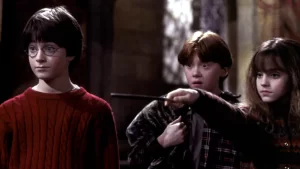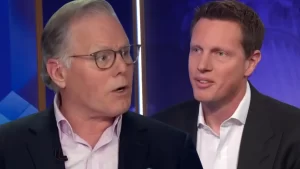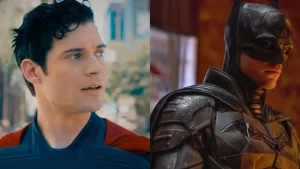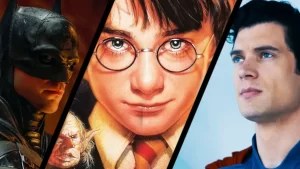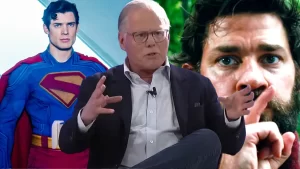Harry Potter and the Deathly Hallows Part 1 is a very proper first half of a singular, six hour film. By “proper” I mean that this film is inescapably incomplete. The last film production that pulled this two-part-film-gag was Quinton Tarantino’s Kill Bill Parts 1 and 2. The main difference between Bill and Harry is that Tarantino was capable of maintaining a satisfactory self containment for both Parts 1 and 2. Though joined by a common story arc, Kill Bill Part 1 carries an undeniable difference from Part 2 as both bring unique tones to their plots, pacing for their stories, and techniques to enhance each experience. This couldn’t be further from the truth for HP7 because just when the audience feels progress is finally being made into the story, the film rolls its final credits and it did so to the half-hearted applause of three people in a crowded theater.
This film, quite literally, takes three hours of real time to get through one and a half acts of the longest of J.K. Rowlings’ Potter novels. Though I am not a personal fan of presenting single films in multiple parts, doing so for Deathly Hallows seems to be an absolute necessity. If there has been any significant criticism of any of the previous Potter films it’s that they have been unable to include every interesting side quest, conversation and character because the books were simply that engrossing. Difficult choices had to be made in the adaptation process to allow the films to take on a life of their own, independent of their literary origin. I am not certain that enough of these “tough” choices were made for this production. Director David Yates and screenwriter Steve Kloves created a structure for part 1 of Deathly Hallows that provides no sense of closure by the film’s end. No, you do not have to point out the obvious to me that this is only part 1. And no, giving this film a pass for not adhering to the classic three act structure because of that fact alone should not be allowed. The Harry Potter film franchise represents the best that classic movie making can deliver and to suddenly depart from that method simply because the story gets “darker” is very risky if not executed flawlessly.
The pacing of the latter 2/3 of Deathly Hallows part 1 is an enduring Cruciatus Curse that twists barbed wire around one’s intestines. This disappointment is amplified by the fact that the beginning of this film engages the hyper-drive with a superb action sequence to get things started. But then the story plateaus when Harry, Ron and Hermione go on their road trip to accentuate an obvious state of somberness for them personally as well as in relation to the state of their magical world. As a result, this pacing leaves a distasteful absence of any sense of reward for an audience that has sat through the slowest, dullest and most depressing of all the Harry Potter adventures. HP7 suffers from too many prolonged scenes of silence and inactivity which is absolutely confusing since the audience is led to believe that the entire magical world is under siege in a violent manner by Voldemort. With so many wasted opportunities to display productive and interesting activity by any characters on the screen, one could begin to make the argument that a two part presentation was less about story and more about money. Leave it to Warner Bros. to squeeze every last bit of blood from Rowling’s franchise before the goose that lays the golden eggs finally gets cooked.
Everything concerning the visual style of Deathly Hallows maintains the extremely high standard that all the Potter predecessors have established. Buying into this world of fantasy has become as second nature as breathing. All subsets of this film’s production staff from Art Director Andrew Ackland-Snow, to Costume Designer Jany Temime, to the entire make-up and visual effects departments produce an unwaveringly consistent reality of this illusion. Creatures and spells, friends and foes all look so good that it almost transforms the canvas of the silver screen into a living portal to another world that begs the audience to become a part of. Every set design is inspiring in its uniqueness and every scene appears as legitimate as that which you can see out your window. But before you all go out and purchase your wizard cloaks, whittle your wands and practice yelling expecto patronum; be forewarned that most of the “magic” is loaded towards the beginning of the film. The absence of visually dynamic magic during the latter portion of Deathly Hallows is a major contributing factor to the aforementioned pacing issues. I must say, however, that the Horcrux effect that is unleashed on Ron was visually imposing and quite shocking as to how sexually charged it was.
And speaking of sex . . . uh, uh, uh, this is Harry Potter and these kids don’t get past snogging (minus the Horcrux effect) and before getting into the actors’ performances I feel the need to address a serious issue regarding romantic chemistry on screen. Youthful coming of age is wrought with sexual tension and the young witches and wizards of the Harry Potter stories are no exception to this fact of life. Of course the main relationship is the non-love triangle of Harry, Ron and Hermione: two potential young lovers separated by a very strong plutonic feeling between them in addition to their equal respect and admiration for the boy that lived. The supposed romantic feelings that have been brewing between Ron and Hermione over the past two films certainly come to an abrupt speed-bump in Deathly Hallows. I am uncertain as to the details that actually bring these two together in the novels, but the Harry Potter films do little more than hint and tease without making any significant headway into building a legitimate connection between these two beyond true friendship. The main reason for this is that Ron and Hermione share virtually no screen time alone for 7 whole feature length films thus far. If Ron and Hermione are in a scene or sequence, rest assured Harry is there as the third wheel. Can we fault Dumbledore for being curios of Harry’s possible affections for Hermione because they spend as much time alone as Harry does with Ron in their Gryffindor dormitories? The point is that if an audience is to believe in this eventual pairing, more scenes need to be written to solidify their mutual attraction. This is not the case for Ron and Hermione in the Harry Potter films and especially true in Deathly Hallows. Their relationship has become defined by varying degrees of jealousy and outright miscommunication that they have practically become the wizard world’s rendition of Ike and Tina. Honestly, I was expecting one of them to come right out and tell the other how they feel because they only have one more film to get this accomplished.
Another curious concern for romantic chemistry is the exploration of Harry’s feelings for Ginny Weasley. Bonnie Wright is effectively alluring in her portrayal of Ginny, but she and Daniel Radcliffe are done a severe disservice by not being given more scenes to evolve their characters’ relationship. The manner in which they hook up in Half-Blood Prince began as a casual attraction that turned into outright romance. Thus, one would expect Ginny to be a significantly more important character to Harry as the story progresses. This may be the case in the novels, but simply isn’t so in the films and in Deathly Hallows, the two actors share only one scene together. Deathly Hallows, as a screenplay, does a fine job of maintaining the importance of friendship among all the young wizards and witches, but when it comes to increasing the status of their relationships to anything beyond that, this script fails miserably.
As much as the Harry Potter series has been about visual effects, this series has equally been about great acting performances that have created perhaps one of the greatest ensemble casts (over the course of many films) of all time. Although the adults are not featured as much in Deathly Hallows part 1, Ralph Fiennes as Voldemort, Helena-Bonham Carter as Bellatrix and Alan Rickman as Snape continue to maintain intense performances as the core antagonists. Sadly, only Fiennes has multiple scenes in Deathly Hallows as Rickman and Carter are curiously underused. Although their combined performances were inspiring, I expect much more in terms of exposure rather than quality from their characters by the ultimate battle in Deathly Hallows part 2.
Rupert Grint as Ron Weasley takes the largest leap forward in terms of his performance and rightly so because Ron is no longer just the goofy side kick. With his character being given more responsibility, Rupert expands his emotional palate from reserved concern, to petty jealousy, to unyielding loyalty. Had Rupert been given the opportunity to get romantic with Emma Watson as Hermione, the two would have certainly hit that scene out of the ballpark. And speaking of Emma, she is definitely called upon to evolve her character past the bossy know-it-all and an– retentive teacher’s pet. Emma Watson’s keen ability to explore despair displays her character as being most adversely affected on screen which is a stark departure from the previous films where Hermione always seemed to be equipped to handle every situation. She masterfully shifts status from assured confidence to frightened uncertainty in a subtle and effective manner. As for Mr. Harry Potter, Daniel Radcliffe once again produces a reliably intense performance for the duration of the film. Daniel embodies the everyman in all the measurable ways from his demeanor to his line delivery and to his reaction to general stimulus. This is the reason why he makes a believable Harry Potter. My only criticism continues to be his lack of proficiency with intimate kissing scenes that once again, rears its ugly head in Deathly Hallows. Perhaps he needs to be reminded of how attractive his female co-stars happen to be so that he can enjoy himself just a tad more in reality to translate into a better performance for the camera.
Harry Potter and the Deathly Hallows Part 1 is a necessary evil. It is a film that must be enjoyed as much it is to be endured because it was so important to the filmmakers to establish the dire gravity within this magical world that they devoted an entire film to it. Better choices in the adapting process could have given this same idea to the audience in a more balanced and efficient manner. Better choices in the writing process would have expanded on the truly remarkable and inspiring acting talent on display for this film. Deathly Hallows part 1 is an extremely sad journey that forces tears to well up in your eyes on multiple occasions. It is unfortunate that this film is awkwardly fragmented, but is hopeful in that we can only imagine the epic high we are all in store for in this franchise’s culmination. Take a ride on the emotional roller coaster that is the Deathly Hallows. The anticipation of the ups and downs will be exciting while the wait to actually get there (in the film) could get mind-numbingly dull.


